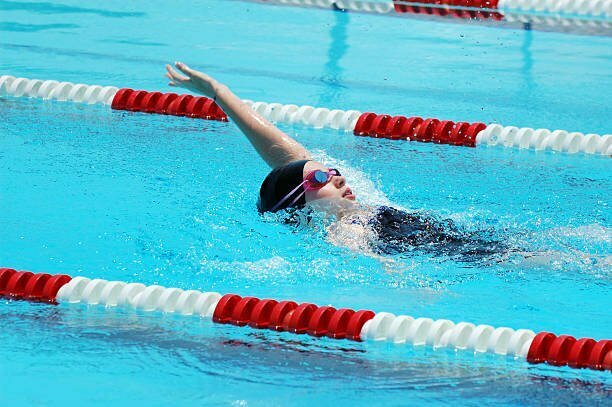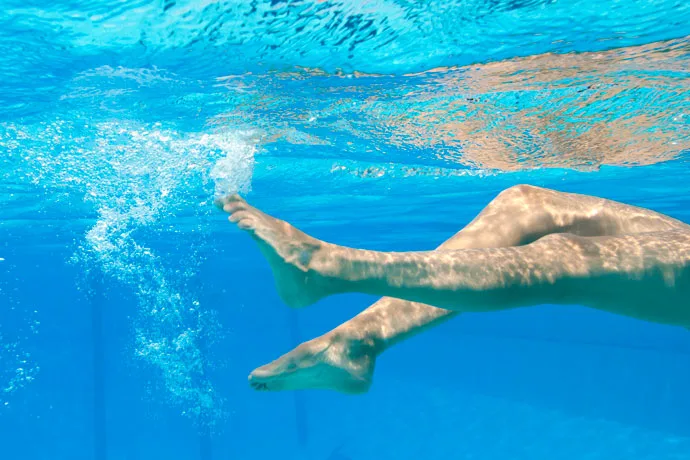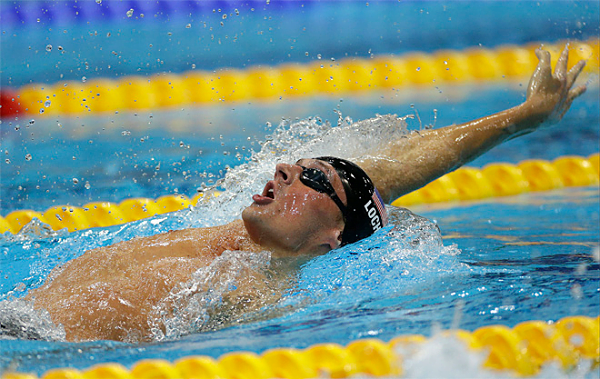Go Swim Istanbul

back swimming Back swimming is one of the swimming techniques that many people describe as the opposite of free swimming, where the body is facing upwards during swimming, and most people refer to back swimming as “the method in which we swim backwards.”
People learn to swim in the backstroke more easily because they do not have breathing problems as in freestyle and it is also called Back crawl swimming.
Never forget to train back swimming It differs from freestyle swimming. In this article on our Free Dive website, we will talk about the most important steps needed for backstroke, leg kicks, and common mistakes.
Technical analysis in back crawl swimming
Depends back swimming It’s completely backwards movements of the hands and it’s a lot like freestyle swimming, but you’re swimming on your back and pushing yourself back.
Many doctors recommend this technique because of its benefits, especially for those who suffer from back problems, or to develop stronger back muscles.

Back swimming benefits
- contribute back swimming It burns a lot of calories, as when a person does this swim, he loses 250 calories in 30 minutes.
- And it helps to improve the position of the body, as this sport offers a wide range of benefits, as lying on the back helps to improve the position of the body, because the muscles need to work to keep the back straight in the water.
- as that Back swimming It contributes to improving the flexibility of the hips, and helps to move the muscles of the arms and legs.
How to perform back crawl swimming
To learn back crawl or backstroke swimming skills, there are 4 important points in the technique of back swimming These are essential elements to keep in mind in order to master the back crawl swimming technique.
- The coordinated movement of the arms in the pacing swimming position
- Rotation of the body while stretching the arm into the position Back swimming.
- Good balance to keep the body straight and maintain speed
- kicks the legs in Back crawl swimming
That all these four main elements support each other. If any of these four points are doubled, it will
First: the movement of the arms in backstroke
- Your arms should be directly out of the water to properly pull the arm into the backswing position.
- When you put the arm in the water, you must first make sure that the little finger is in the water, that is, the palm of your hand should be facing outward.
- After the arm enters the water, it is lowered slightly and the elbow is slightly bent and the water is pushed up the side of the leg.
- When the push is finished, the thumb should come out before the water, that is, the palm should turn inward. In order to achieve proper arm traction in a back crawl position, you need to ensure synchronization, so it is very important that both arms perform the same movement.
- Rotation of the body during the arm pull is very important in mastering your technique while performing the arm pull correctly. The backstroke technique cannot be successfully performed without the rotation of the body.

Second: Rotation of the body while stretching the arm in the back swimming position
- While performing the arm lift in the position Back swimmingyou need to provide a rotation of the body using the shoulders.
- Coordination of your right arm in the event of a push and as soon as you begin to get out of the water, the left arm begins to enter the water.
- At this time the right shoulder comes out of the water and the body turns to the left at an angle of 45 degrees.
- In the same way, your left arm has completed the water push and as soon as it begins to get out of the water, your right arm begins to enter the water. This time the left shoulder is out of the water and the body is turning to the right at a 45-degree angle.
- This rotation allows your arms to reach farther. In this rotational motion, the body must be straight.

Third: Putting the body in balance in backstroke swimming
- You need a firm stomach, firm hips, and proper foot strokes to achieve a firm body position. Back swimming.
- In order not to weaken your hips, you must keep your abdomen and hips pulled and supported with foot kicks.

Fourth: kicks of the legs in backstroke
As we mentioned earlier in our article on the correct foot kick in the technique of back swimming Where:
- Correct action is with the foot in position back swimming It is the last and almost the most important component of backstroke technique.
- Foot strikes support a tense body posture.
- The legs should be close together and it is very important to bend the knees slightly.
- You need to make small, quick movements by taking the force of the kicks of the foot from the hips.

Fifth: Breathing technique in backstroke
The training of breathing techniques in swimming differs due to the type of swimming used, as each type of swimming has a special method of breathing, as these exercises help in increasing endurance and achieving rhythm in the breathing process.
and consider back swimming One of the easiest swimmers to breathe, as the swimmer breathes normally by breathing through the mouth and exhaling through the nose.

Steps for teaching back crawl swimming
With our series of swimming lessons at Free Dive, you can learn back swimming Step by step, under the supervision of professional trainers in our center. The series can be divided into the following stages:
- You can practice the flutter kick on your back while holding the edge of the pool.
- Next, you can practice balancing by floating on your back and side and using the flutter kick to move forward.
- Then, underwater and overwater arm movements are practiced separately with each arm.
- Finally, you can practice both arm movements simultaneously.
Common mistakes in backstroke
- Not straightening the two metacarpals, widening the distance between the legs, as the horizontal position of the body must be maintained, the hips raised, the head lying back and looking upwards.
- Back arch due to head diving in water and must be repaired through exercises for the legs using the kickboard
- Increasing bending of the knees and falling of the torso and it must be fixed by slowly moving the legs with increasing depth and training the legs using a swimming learning board.
- Incompatibility between the movement of the arms and the strikes of the legs.
- The arm is lowered away from the level of the face and the arms are extended during the tension and the arms are not bent, and it must be fixed by focusing on directing the hand towards the foot for the longest distance.
- Failure to breathe in a good way, loss of balance and repetition of looking to the sides and must be fixed by regulating breathing and taking inhale from the mouth and keeping the knees under the surface of the water.
Features of Free Dive Pak Swimming Training (Back)
- We work at the Free Dive Center to train the trainees on the correct backstroke technique through theoretical and practical lessons.
- We use the latest possible means that help the recipient understand the mechanism Back swimming Breathing correctly, and the body and muscles need for oxygen during the swimming process.
- We at Free Dive Center have specialized and qualified trainers to train back swimming skills and techniques in a smooth and simple way.
- We take the most important measures that may help the trainee and his mastery of skills and steps Back crawl swimming Increasing the confidence of the trainees with practical steps.
- We are working on training people to swim back practically and in gradual steps, starting from zero to professionalism.
Frequently asked questions about backstroke
When did backstroke appear?
Backstroke was developed as an offshoot of front crawl, in which swimmers imitated the axillary technique on their backs. One of the most important developments in the history of backswimming occurred in the late 1930s when Australian swimmers began bending their arms and experimenting with backstroke.
What are the disadvantages of back swimming?
One of the disadvantages of backstroke is that it is a slower swimming stroke than the front crawl or butterfly. For beginner swimmers, it can be difficult to find balance in the back and then breathing becomes a problem as the nose rises and water can easily enter the nose.
What is the main purpose of backstroke?
The main purpose of backstroke is to allow you to catch your breath and lower your heart rate at any moment while swimming in open water. Sometimes using a stroke other than freestyle can make the racing experience more enjoyable and relaxing
What are the tips of deep dive coaches in backstroke?
1. When improving your backstroke, aim to keep your body position as flat as possible so that it is streamlined in the water with a slight slope to the hips to maintain leg movement underwater.
2. Don’t let your hips drop too much as this will slow you down – try to keep your body close to the surface of the water.
3. Your head should be steady and your neck relaxed. Lifting your head high will strain your neck and slow you down in the water.
4. The water level should cover your ears and your eyes should look up and back.
Sources
Improving Your Backstroke Technique | Swimming Tips and Advice
How to Swim the Backstroke: 3 Backstroke Swimming Tips – 2022 – MasterClass
Swimming Lessons in Istanbul
Baby Swimming Lessons in Istanbul
Free Diving & Scuba Diving Lessons in Istanbul
